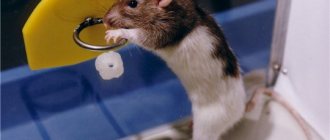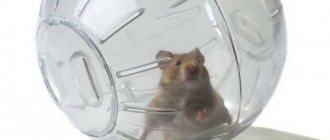What is it really like to have a pet rat? Owning a pet rat is a wonderful experience if you have the time to care for them. These rodents are especially active at night and are very social, and you should keep this in mind when deciding whether you should get a pet rat. But let's take a closer look at the pros and cons of owning a pet rat.
General characteristics of rats
Compared to men, women are more active than men, while men are more phlegmatic and somewhat lazy. But regardless of gender, rats are very affectionate and will enjoy being petted and caressed by their owners.
In addition, the following characteristics of domestic rats can be distinguished:
- purity;
- unpretentious service;
- receptive to training;
- curiosity and intelligence;
- sociability.
Keep in mind that when purchasing such an animal, each individual may have both pros and cons.
For example, a sufficiently developed intelligence can create problems: it can easily open simple locks and latches in a cage. But at the same time, the developed intelligence of the rat makes this animal unique: it recognizes its owner and can learn simple tricks.
Remember also that a rat is a rodent, and if you give it the opportunity to roam, you must take care of your furniture and property and make sure that your pet does not eat anything dangerous to its health.
Ancestral rats and current wild animals live in packs, so the rat needs friendly communication, and if you do not have the goal of breeding, then it is advisable to get two animals of the same sex. Rats of the same sex will not fight over territory, so there is no need to worry about possible conflicts, and the main advantage is that they will not produce unwanted offspring.
But even with a roommate, the animal must communicate with its owner. It is necessary to spend time so that the animal becomes sociable, is not afraid of people and does not show aggression towards people out of fear.
If not tamed, it will become unsocialized and may become aggressive towards its owner due to fear of a person many times its size. There have been cases where domesticated rats have attacked people, to avoid this, you must pay attention and take care of your pets.
Domestic rats - breeds and description
Every year, the popularity of keeping rodents at home is only increasing, this is due to ease of care, as well as intelligent and active behavior. A tame rat is easy to train; in addition, it is even interesting to simply observe its life and movements around the cage. Depending on the species, the pet has a different coat color; other differences are not so significant. When looking for information on how much a pet rat costs, you need to understand that the price directly depends on the type of animal and can reach $15.
Rats as Pets – Pros and Cons
Thanks to its small size, the animal will fit perfectly into any living space. A domestic rat, a photo of which shows the external characteristics of the animal, has positive and negative sides, and they need to be taken into account when deciding to get such a pet. Among the advantages are the following points:
- high intelligence;
- ease of care;
- unpretentiousness in feeding;
- friendly character;
- no need to walk;
- cleanliness;
- high immunity;
- low noise level;
- minimal maintenance costs;
- you can take it with you;
- There is practically no smell.
Among the disadvantages are the following:
- the animal must not be left unattended outside the cage;
- training involves regular contact;
- Possible allergy to pet rat;
- they taste everything that comes their way;
- does not get along well with other animals;
- short life expectancy.
Types of domestic rats
Some beginners believe that these animals have certain breeds, but in reality this is not the case. Decorative rats are divided into several varieties, mainly depending on the color and condition of the coat. Among the large variety, the following stand out:
- Standard
. The coat is smooth and glossy. - Dumbo
. He has large ears, which are also low set. - Sphinx
. It differs from others in the absence of hair. - Anurans
. The decorative rat stands out from others due to the absence of a tail. - Double Rex
. They have an original coat, where curly areas alternate with completely hairless ones. - Satin
. The coat is shiny and silky. - Husky
. The coat color combines gray and white. In terms of the color of their fur, domestic husky rats resemble dogs of the same breed. - Rex
. The fur is denser than that of the standard breed and at the same time curly.
How long do pet rats live?
When deciding to have such an animal at home, you need to take into account all the nuances. Many future owners are interested in how long rats live at home. Some breeders claim that with good care, these animals will be able to cross the six-year mark, although in fact this is more of an invention to attract buyers. In fact, the average domestic rat lives no more than three years, and only healthy individuals with excellent health are capable of such a long life.
Where to buy a pet
What really matters is where you buy the rodent. When it comes to pet stores, the animals they sell are usually raised on large farms.
These farms raise most of the rodents as food for predators such as snakes. As you understand, little attention is paid to the care, feeding and maintenance of animals on farms. Animals raised in such conditions are flirtatious, restless and more difficult to tame.
Breeders pay great attention to the living conditions, nutrition, care and health of animals. Therefore, it is believed that breeders are the best place to buy.
Small rodents are easy to handle, they tolerate moving to a new home well and quickly become attached to their new owner, they are calm and friendly. Breeders can talk about the parents of the rats, introduce them to the characteristics of the breed, and give recommendations for further breeding.
However, it is worth saying that no matter where you buy, a lot depends on the owner. Any rodent will eventually become tame and affectionate if it is treated with care, love and attention.
Raising rats is considered one of the easiest compared to caring for other types of pets. Rats are easy to train, they are loyal and sociable, friendly to people.
Tamed animals love to spend time with small children, but adults will not get bored with them either. Rats especially enjoy it when their owners scratch them on their bellies or behind their ears. They can spend hours with their owners without being intrusive.
Some species of rats have chosen favorites among members of their extended family, but they are happy to socialize with anyone. If the owner is sad and the animal senses it, it may try to cheer him up with funny faces or sounds. Rats are one of the few pets that can laugh when tickled.
The average lifespan of a rodent is about 2 years. However, if the owner manages to care for the animal properly, this period can be extended to 4 years. Rats are so unpretentious in their care that even a middle schooler can handle them, with whom rats often become best friends.
In the wild, rodents are nocturnal and sleep during the day in preparation for the next hunt. If the rat is smart, it can get used to this day. And if a person himself is an owl by chronotype, then there is no point in changing the rhythm of the animal’s life; it does not interfere with daily functioning.
Sometimes you can pet him at night; owners claim that the contact with their pet is deeper at night when no one distracts them.
A rat is a rodent from the mouse family, which has more than 64 species. Rats have been bred as pets since the 19th century, and as new breeds have been developed, they have become different from their wild ancestors. During the breeding process, the most peaceful rodents were selected to prevent future outbreaks of aggression towards humans.
However, despite the fact that the ornamental rat has a different character than its wild relatives, it is very important to buy an animal from a trusted place that is bred and kept in proper conditions and without diseases. When buying such a rat, you can be sure of its safety.
Reputable means purchasing your pet from a reputable breeder or pet store. When buying a rat from a pet store, pay attention to how it is kept: cages should be clean, food bowls should be filled with fresh food and clean water. The animal must be active: if the animal is lethargic and inactive, this may indicate illness.
In what cases should you refuse to purchase a rat?
Despite all the positive qualities of decorative rats, in some cases it is still better to refuse to purchase rodents as a pet:
- The family has small children. Rats get along great with kids. But, unfortunately, animals very rarely live longer than 3 years. Therefore, the child will inevitably experience the pain of loss. It is quite difficult for children, especially preschool age, to explain what happened to the pet and where it went. Moreover, situations cannot be ruled out when the furry dies right in front of the child. Particularly impressionable children can receive real psychological trauma.
- Lack of free time. Despite the fact that rats are capable of keeping themselves occupied, they will still need to be given a certain amount of attention every day. In addition to communicating with your pet, you will need to find some time for feeding, cleaning the cage, treating, and bathing the animal. People who often go on business trips should especially give up the idea of getting a rat. Even if you ask a neighbor or friend to care for your pet, the animal will be constantly under stress due to the change of owners.
- At least one family member has allergies. Like any animal covered with fur, a rat can cause severe allergic reactions in the form of skin itching, hives, and swelling. In rare cases, a life-threatening condition such as anaphylactic shock may occur. The only exception is the hairless sphinx rat - it is completely hairless, so it does not cause allergies.
- Presence of cats or dogs in the house. Rats are quite friendly towards other pets. But if the hunting instinct awakens in a larger animal, the rodent will, at best, receive serious injuries. And in the worst case, he will be eaten. If you decide to get a rat, you will need to protect it from potential danger.
Having carefully studied the advantages and disadvantages of a domestic rat, everyone will understand whether it is worth having an animal as a pet. When making a choice, you need to carefully weigh the pros and cons, since an animal is not a toy, but a real family member with whom you will have to spend a lot of time.
How to choose a pet
When choosing a pet, pay attention to its behavior, since active and curious animals usually get used to people faster, and cheerfulness is also a sign of good health. Being too calm and quiet may indicate health problems.
Examine your pet, his nose, eyes and anus should be free of discharge. His coat should be well-groomed, beautiful and clean. They are very clean and spend a lot of time cleaning.
The skin on the ears and tail should be intact, pink and clean. Check the fur for parasites or lice. If you have lice, you may see parasite eggs behind your ears.
The rodent should breathe easily and calmly; difficulty breathing and sneezing indicate respiratory diseases. There should be no moisture around the mouth; excess saliva may indicate dental problems.
Benefits of rats as pets
- Rats are known for their highly intelligent
They can learn tricks and commands such as picking things up for you, answering your name, etc. These rodents can also solve puzzles and collect treats you hide. There are even pet rats that are trained to find mines for the military. They are also very easy to litter box train, making cleaning up after them much easier.
- Pet rats are clean
They spend most of the day licking and preening themselves. This makes caring for them much easier. As mentioned earlier, they can also be trained to use the litter box.
- They are inexpensive.
If you have the budget, a rat may be the perfect pet for you and your family. They are also inexpensive to maintain. The owner will have to spend money on a cage and a few toys for them, but in general, rats are quite cheap.
- These rodents do not require special care
They do not require walks, very rarely need grooming, and although their diet should be healthy and varied, there is relatively little food that they cannot eat. And because they are active at night, they don't whine when their owner goes to school or work - they just sleep.
Most of the work you will need to do is cleaning their cages from time to time and changing their litter box to keep the room and cage odor-free. They also need attention, but this applies to all pets.
- They are very affectionate and easy to bond with.
Not only among themselves, but also with their owners. In fact, hobby rats recognize their owner very easily through various senses. They will actively search and play with other rats and you. Rat animals will also sleep together most of the time.
They love to cuddle with you, play with their hands and enjoy being stroked if they are used to it from an early age. They even make something called Brussels sprouts. Pets chatter their teeth to express their love for you.
But the extent of their feelings depends on several things. If they are not used to you yet, they may seem scared and run away from you. You must earn your pet's trust by giving him treats, spending time with him, letting him get to know you, and so on.
That's why it's so important to pay attention to your pet!
Not only will they become more affectionate by spending more time with you, but they will also feel happier. Rat animals are very susceptible to depression, which is most often caused by lack of attention to them over a long period of time. This happens quite often, especially if you only have one rat (which you shouldn't do, always buy a pair).
How you express love also depends on the gender of your rat. Male pet rats tend to be lazier and want to cuddle more often. Female rats, on the other hand, are more energetic, curious and always on the move, so they will often have to play with you.
- Pets are great first pets for children.
Since they are fairly low-maintenance pets, they are ideal for small children. The child will easily learn to care for them. By caring for rodents, children can learn responsibility for the animal and will have a buddy to talk to at any time.
- Each rat has its own personality
They are very emotional and react differently to different things. For example, some pet rats love to chew on toys and destroy and chew on everything. While others like to run after balls and push them. Some people like to be lifted and carried on their shoulders. Others will just want to lie on your lap and sleep. There are many different types of rat pets, and you never know which one will be yours.
- Rats are not too big and not too small
At maturity they weigh from 200 grams. (girl) up to 700 gr. (big boy) and have a strong, durable body structure. This makes them quite easy to handle, even for children. But a few rats in a decent cage still doesn't take up much space in the house.
The main advantages of keeping a rat
Fortunately, the advantages of decorative rats are much greater than the disadvantages. Below are listed only the main positive qualities of the animals.
High socialization
Rats do not tolerate loneliness very well; they prefer to live in small same-sex groups. At the same time, animals show care for their relatives:
- brush each other's fur coats;
- feed weakened individuals;
- show sympathy;
- warn of impending danger.
Fights and conflicts between rats are a very rare phenomenon, which is observed mainly in males during sexual activity.
High cognitive abilities
Contrary to popular belief, rats are very smart. Their intellectual abilities are on par with cats and dogs. Rodents remember their name well and are easy to train.
Fluffies can be taught on their own such commands as “give me a paw”, “lie down”, “come to me”. Rats also perform simple tricks - walk on their hind legs, roll a ball, spin around their own axis, jump from place to place.
Easy to care for
The cute fluffies are quite easy to care for. Difficulties may arise at first, but the main thing is to get used to it. By choosing a cage with a removable tray, cleaning takes literally 10-15 minutes.
Sawdust or shredded toilet paper are used as filler. You can feed your rodent either specialized food or natural food. The only caveat is that you need to remember the list of prohibited products.
Doesn't take up much space
Decorative rats are quite compact. Their body length is about 20 cm. Therefore, several individuals can be kept in one multi-tiered cage at once - up to 5-6 pieces. The rat house itself does not take up much space. The cage will easily fit on a desk or bedside table.
Affordable price
The price of a decorative rat, even one raised in the most prestigious nursery, is unlikely to rise above 2,000 rubles. And at the poultry market or by hand you can buy a purebred pet for only 500-700 rubles.
It is better to buy rats from professional nurseries. Because pups raised by experienced breeders are more socialized and healthier.
Easy to transport
Rats tolerate moving well even over long distances. All that is required for comfortable transportation is a special carrier with a secure lock, while ensuring air circulation. The small weight of the animal - within 500 grams - will prevent the owner from getting tired during the trip.
Big choice
There are many breeds of decorative rats, so everyone will find a pet to their liking. Among the varieties there are different animals: compact and bulky, bald and fluffy, with straight and curly hair, with large and small ears, albino and fluffy with complex colors.
Cleanliness
Many people believe that the destiny of rats is to climb through garbage dumps and rummage through garbage. However, ornamental animals are very different from pasyuki. Cute fluffies are very clean.
They perform daily activities to maintain the cleanliness of their body: they wash themselves after each meal and lick their fur. And if several individuals live in a cage, they happily clean each other’s fur coats. In addition, decorative rats love to swim. The owner must take care of organizing water procedures.
Attachment to the owner
Rats quickly get used to their new owner and happily spend time with him. In addition, cute animals gradually get used to the rest of the family members. If a rodent feels good about itself, it will never bite, scratch or run away from home.
Possibility of litter training
Rats are very smart, so they can be trained to go to the toilet in one designated place. This will only require a few trays (according to the number of pets in the cage) and a little patience.
The duration of toilet training is from 2 to 4 weeks. If the rat gets used to the litter box, the process of cleaning the cage will take much less time.
Activity
Decorative rats are very active - they really like to play with their relatives, exercise on apparatus in the cage, and explore everything new. It is very interesting to observe the life of fluffies from the outside. If you have free time, you can spend hours on end watching cute animals frolic.
Since rats are very active, it is better to purchase multi-tiered cages for playful animals. 2-3 floors will be enough for males, 4-5 tiers for females.
No need to spend a lot of time together
Rats love their owners very much and are always willing to play with them. But if the furry owner doesn’t have much time to spend together, it’s okay. Fluffies are able to keep themselves busy - they exercise on apparatus, play, and frolic with their cage neighbors. At the same time, the rodent does not develop any resentment towards humans.
No need to go outside
Other pets, such as cats and dogs, need a lot of space. In addition, such large pets prefer to go to the toilet outside.
With rats everything is much simpler. The little animal feels quite comfortable in a cage. And to release the accumulated energy, a play complex installed in a cage is enough for a rodent.
Cons of decorative rats
- Rats don't sleep at night.
This may be a disadvantage for you, or it may be an advantage. Depending on your schedule, you may be able to enjoy their company more. For example, if you work during the day and come home in the evening to relax, this could be a great opportunity to bond with your pet.
On the other hand, if you work mornings and afternoons and go to bed early, you may not have much time to enjoy the active company of your pet rat. But these rodents change their schedule to be more active when you're around, so take that into account.
- These rodents don't live long
Rat animals live from 2 to 3 years, so when choosing them as a pet, you should take this fact into account. It's not much at all, and the time will pass faster than you think. Especially if you become emotionally attached to your pet.
- They get sick easily.
They can have quite a few congenital diseases in rats, such as breathing problems, tumors, and spinal problems. They will likely need medical care throughout their lives, so know that you will have to take them to the vet to address some of these issues.
- In most cases, male rats should not be kept with female rats.
Unless your pet is neutered, you should not allow rats of different sexes to live together. Female rats can become fertile at 5-6 weeks of age and can give birth to a litter of 10 babies in less than a month. Therefore, if you have rats of both sexes, you should either neuter them or keep them in separate cages.
- Pet rats need a lot of space to live
We're not talking about little hamsters here. Rats are a bit larger and will need a lot of space to live. This means you'll either have to buy a fairly expensive cage or build your own if you can afford it.
- Rats need attention
Rat animals are very sociable and need daily attention. Therefore, you should always have more than one pet rat at a time. If they are left alone for a long time, they become increasingly depressed and may even die from it.
- Pet rats love to bite
It mostly depends on the personality of the animal, but the average rat will chew on anything that interests them. It doesn't matter if it's a toy, a box or a computer power cord - they will chew through it. You either need to protect everything from rats or just keep an eye on them.
Cons of content
Unfortunately, rats do not have their drawbacks. But the shortcomings of these cute rodents are very minor, and they can be easily dealt with.
Tendency to diseases
Rats have a fairly weak immune system, so fluffies often get sick. In addition, a predisposition to certain diseases is inherent in them at the genetic level. Most often, rodent owners encounter the following ailments of their pets:
- ARVI;
- malignant and benign neoplasms;
- mycoplasmosis;
- atherosclerosis;
- renal failure;
- pneumonia.
Rats also often suffer from fleas, lice, ticks, worms and other parasites.
Short lifespan
On average, rats live about 3 years. Compared to other types of pets, this is a very short period of time. Some varieties of decorative rats, for example, albinos, live only 1.5-2 years. Long-livers are also found among rodents. With proper care and timely treatment, a rat can live up to 4-4.5 years.
Marking territory
Some novice breeders mistakenly believe that only males mark territory. However, females also put their marks everywhere. The only difference is that the urine of male rats has a more pungent, specific odor. Regular cleaning of the cage will help solve this problem.
Unpleasant smell
During the life of a rat, like any other animal, an unpleasant odor is released. And it doesn't just come from excrement or urine. The endocrine glands also emit a specific aroma, to get rid of which you will have to regularly subject your pet to water procedures.
Unpleasant associations
The appearance of rodents, to put it mildly, scares some people away. Some consider cute decorative fluffies to be as aggressive as their wild relatives. And some breeds, for example, the Sphynx, are generally terrifying to especially impressionable people.
Damage to things
As long as the rat is in the cage, its owner’s property is completely safe. But rodents are very agile and are able to open a weak lock on their own. If he escapes, the fluffy will chew everything that gets in his way - furniture, wallpaper, clothes, wires. Therefore, it is recommended to place even a cage with a rat away from walls and any things - otherwise the rat can reach them through the twigs.
Noise at night
Rats are nocturnal animals. Therefore, they often go to bed only in the morning. And at night they stay awake, play, frolic, learn everything new. This feature can cause discomfort to owners, especially if small children live in the house. To ensure that pets do not disturb anyone’s sleep, it is better to place the cage in a separate room.
Aesthetic problems
Adult male rats have very prominent genitals. This is especially noticeable in representatives of short-haired and hairless varieties. This feature is very off-putting or confusing for some people.
Expensive treatment
The health of rats is quite poor; fluffies get sick very often. Therefore, they will have to be treated constantly, paying considerable sums for medical services. Moreover, ordinary veterinarians rarely work with such small animals as rodents. Most likely, you will need to look for a special doctor for rats - a ratologist.
The problem is aggravated by the fact that there is only one specialist for 2-3 cities. Therefore, for treatment, you may have to transport the animal to a neighboring village.
Rat care
Caring for pets is not difficult at all, all you need is basic cleanliness and general guidelines.
When keeping pet rats, cage cleaning should be included in your schedule. Changing the drinking bowl daily, as well as replacing dirty bed linen as necessary, are mandatory rituals. Periodically disinfect your pet's cage, especially the items he uses the most.
Pets are considered one of the most undemanding animals and easily adapt to their environment. From time to time you can walk around the apartment with your pets. However, it is especially important to keep an eye on them if there are exposed electrical wires or valuables in the apartment that are visible to everyone.
It is important for the owner to know a few general rules for keeping and caring for pets in order to avoid trouble:
- The cage should be placed in a place protected from direct sunlight;
- Include basic cage cleaning and changing feeders and drinkers into your daily schedule. It is advisable to have both regular and suspended cages at different levels;
- Twice a week the cage must be thoroughly cleaned and disinfected;
- If necessary, the animal should be bathed in water at room temperature;
- Trim your pet's nails regularly with special nail scissors.
Due to the fact that pets need exercise, it is necessary to periodically provide them with the opportunity to walk around the apartment. Experts advise to first allocate free territory for him. And as soon as he gets used to the name, he can be periodically released throughout the apartment, but be sure to keep an eye on wires and personal belongings, especially important ones that were not left unattended.
Ferral rats are worthy candidates for pets and full members of the family.
Anyone who has ever come into contact with this charming creature will no longer remain indifferent to them. Rats are especially good with children and can develop in them a sense of responsibility for their friends and the ability to care for animals.
Children report that rats often become their best friends. This is especially noticeable in introverts or people who have difficulty communicating, such as those who have been bullied at school.
For irresponsible people, the rat will help them master the necessary qualities and value contact with the environment more. Experienced people began their adventure in animal care by breeding rats.
It is recommended to keep your rat in a cage. The inquisitive nature of the animal, if allowed outside, can cause great damage: while exploring new territories, the rat can damage objects/furniture and harm itself. When releasing the animal, try to keep it in sight and do not forget to return it to the cage after the walk.
Although the rat is a very clean animal, the cage should be cleaned on time, old food removed, water and bedding changed to avoid odors. Timely cleaning of the house will prevent not only unpleasant odors, but also the development of infections that can trigger the development of diseases.
In addition to cleaning, your pet needs a balanced diet, which can be purchased at any pet store, as well as a bed and other necessary accessories for play.
But nutrition for a rodent includes not only the purchase of food; for the rat to be fully nourished, it is necessary to give fruits, vegetables and herbs, and you can pamper yourself with purchased delicacies.
Required purchases:
- cell;
- a bowl for water and food (possibly a drunkard);
- gaming accessories;
- Bed sheets.
The first thing you need to provide is a comfortable cage with opportunities for active play. Filler, constant access to water and food must be available at all times. Rats are clean animals and do not require frequent changes of bedding. An aquarium is not suitable for a home, as it is poorly ventilated and a rat can simply suffocate in it. If finances allow, you can buy a three-story house with a large number of different exercise machines and other equipment. This will help the rat keep enough exercise when the owner is very busy.
In addition to size, a rodent cage must meet a number of the following simple but important requirements:
- The strength of the metal rods from which the cage is made. The distance between them must be at least 10 mm.
- A deep pan is very important.
- If simulators are present, they must be securely secured.
- Printing paper without ink can be used as filler.
- There should be a drinker in the house with clean water available at all times.
- The presence of a shelter where the animal can rest, hiding from prying eyes.
Domestic rat - care and maintenance
These pets are so clean that with regular cleaning of the cage, an unpleasant odor will never appear in the house. Other features of care include the following:
- Walking around the apartment unattended will lead to damage to cords and other objects that the pet encounters along the way.
- Domestic rats, whose odor is almost inaudible to humans, can be detected by other animals living in the house. Nothing can be done, so they mark their territory.
- Rodents are afraid of drafts and direct rays of the sun; this must be taken into account when looking for a place to place a cage.
- When figuring out what pet rats like, one cannot help but note their desire for attention. If possible, take your pet out of the cage and play with it.
Cages for pet rats
Many people, looking at the relatively small size of these animals, think that a small house will suit them, but in fact this is not the case. Domestic rats are very mobile and therefore the minimum cage size for a full life should be: 40x30x50 cm. The following accessories must be present in their home:
- filler;
- house;
- tunnels and stairs;
- mineral stone;
- drinking bowl;
- feeder;
- different toys.
What to feed your pet rat?
Animals need suitable food to live a full life. Those who have just bought an animal or are planning to do so are interested in what domestic rats eat. The basis of the diet of any rodents is grains. In addition, clean water should be available in the public domain. Feeding should be done twice a day: 30-40 g of grains, 10-12 g of vegetables, no more than 15 g of protein products 2-3 times a week. A complete diet must include the following products:
- vegetables (cabbage, carrots, potatoes, eggplants);
- fruits (bananas, apples, grapes);
- greens (parsley, cilantro, dill);
- cooked meat;
- seafood;
- egg;
- cottage cheese;
- cheese;
- low fat yogurt.
Prohibited foods for pet rats include the following:
- chocolate;
- confectionery;
- beans and beans;
- Brussels sprouts;
- smoked sausage;
- chips;
- soda;
- juices
How to wash a rat at home?
These animals are divided into the following categories: lovers of water and those who absolutely cannot stand it. These pets are so clean that there is no need for “routine” bathing and this should not be done unless necessary. Regardless of breed, pet rats should only be bathed in the following cases:
- unpleasant odor;
- heavy pollution;
- unkempt appearance of fur;
- the need to remove parasites.
It is recommended to refuse the procedure if there are wounds or scratches on the skin. Among other things, feeling unwell is a reason to refuse swimming. When contamination is present in a small area of the body, it is better to do “local” cleaning. The bathing procedure must comply with the following rules:
- There should be no drafts in the room.
- Take warm water.
- The animal must reach the bottom with its paws.
- The procedure is carried out using a special shampoo.
- Water should not get into the animal's eyes and ears.
How to train a rat at home?
You can teach an animal to perform any tasks only using the motivation method in the form of treats. In order to understand what tricks you can try, you need to watch your pet. Among the main ones are the following:
- rearing on hind legs;
- running on a vertical surface;
- carrying small objects in the teeth;
- jumping between supports;
- simple acrobatics.
Having noticed all these skills, many will want to know how to tame a pet rat and teach it to do such simple tricks. This will take time and a lot of patience. Training should take place according to the following rules:
- the pet's hungry stomach;
- a familiar training place;
- refusal of physical assistance during stunts;
- each training session begins with repetition of what has been learned;
- treats are given only for results;
- use any sound signal.
Diseases of domestic rats
Even high immunity does not protect against the fact that these pets sometimes get sick. In order not to panic and search for information on what to do when a pet rat gets sick, you need to know what health problems these animals may have. Among the most frequently occurring ones are:
- Listeriosis
. A dangerous disease even for humans. Symptoms: apathy, high fever and damage to the nervous system. - Tail syndrome
. Appears as a result of low humidity in the room. Symptoms: ulcers at the base of the tail, shaped like rings. - Colibacillosis
. The causative agent is Escherichia coli. The first symptoms: refusal to eat, liquid stool and, as a result, dehydration. - Salmonellosis
. The disease is bacterial in nature. Symptoms: diarrhea, shortness of breath, swelling and paralysis. - Econometry (smallpox)
. Symptoms: ulcers and swelling on the skin. The infected pet rat is euthanized. - Pneumonia
. Caused by viruses. The main symptoms include: sneezing, mucus from the nose and eyes, difficulty breathing, red eyes and swelling of the throat. - Mycoplasmosis
. The infection leads to the following symptoms: swollen lymph nodes, otitis media, pneumonia.
What can you get infected from a pet rat?
The risk of contracting any serious disease with proper care of the animal is minimal. However, there is information that a domestic rat, white or another color, can transmit the following ailments to its owner:
- Streptobacillosis (Haverhill fever)
. A very dangerous bacterial disease that can lead to death. You can become infected by being bitten by a sick animal. - Hemorrhagic fever with renal syndrome
. A person's kidneys are affected and urine production stops. The method of infection is the ingestion of excrement from a sick pet. - Leptospirosis
. A bacterial disease in domestic rats that affects internal organs. Problems begin after urine or saliva from an infected rodent enters the body. - Parafit
. Caused by microbes from the Salmonella group. Very dangerous for the animal. Infection through water containing animal secretions. - Helminths
. They reach animals through stale food or water. People become infected through close contact; for example, many people like to kiss their rodents.
Is it true that they are marking territory?
Many people say that they leave drops of urine everywhere. This behavior is quite normal; rodents in nature have the right to mark their territory.
The fact is that urine contains a huge amount of information that they leave for their relatives.
They not only mark their territory, but also convey information about age, social status, sexual maturity and stress. Marking territory is more common among men, but women are no exception.
During walks, owners often lay out a special fabric to protect carpets and furniture from such “scented” traces.
Sometimes pets urinate on themselves, but this is not due to markings, it is a sign of illness and you should contact your veterinarian. If you skip the labeling issues, they are usually very clean and easy to get used to in the litter box.
Diseases of decorative rats
Rats, like many other decorative rodents, can be infected with various diseases, some of which are also dangerous to humans. Parasites, bacteria, viruses and fungi can cause illness.
These diseases are common:
- Ectromelia (also known as chickenpox) is a virus that, once in an animal’s body, multiplies on the skin and internal organs (in the chronic form, ulcers, swelling and spots appear on the skin, ending in tissue necrosis and gangrene; in the acute stage of symptoms, it can not be, but the rat dies within 24 hours);
- Listeriosis is a bacterial infection that is also dangerous to humans (infection occurs through bedding, food and cage accessories); body temperature rises and coordination is impaired;
- Salmonellosis, a bacterium manifested by apathy, diarrhea, intermittent breathing, and without treatment progresses to swelling, paralysis and irreversible organ damage (treated with antibiotics - chloramphenicol, biseptol, sulfadimethoxine);
- Pneumonia is an infection of the respiratory system by pathogens of coronavirus and Sendai virus, manifested in the form of nasal and eye discharge, sneezing, difficulty breathing, redness of the eyes, swelling of the throat, lethargy and weight loss (treated with a course of antibiotics, anti-inflammatory drugs, immunomodulators, vitamins);
- Mycoplasmosis is a genital, respiratory or mixed infection manifested in the form of lymphadenopathy, nasal discharge and pneumonia (the form of the genital organ may be asymptomatic);
- coccidiosis - a disease of the intestines and liver with frequent digestive disorders, jaundice, and exhaustion;
- Scabies and actinomycosis is a fungus that is acquired by rats through flea or tick bites or through contaminated food (symptoms include sores, gray blisters, scabbed skin, hair loss, and sores on the mucous membranes in the mouth).
Many diseases can be avoided by washing your hands after handling the animal, feeding it proven food and keeping the cage clean.
Now you know how to take care of a rat at home. It’s not difficult to follow all the recommendations, but your wise pet will definitely thank you with his attention and love.
Types of pet rodents Eye diseases in guinea pigs Domestic ferrets - is it worth having a home? Health of pet rodents How to bathe a hamster How to toilet train a hamster? Domestic Dwarf Hedgehog Determination of sex Rabbit breed Tips for breeding rats
Some facts about the decorative rat
Most ornamental pet rats are a species of gray rat (Rattus norvegicus). Its other names are: Norway rat , common rat , street rat , sewer rat or pasyuk . The gray rat's body is usually between 20 and 30 centimeters long, with a tail up to 20 centimeters long.
Rats come in a wide range of colors (including amber, agouti, and sable). And also different types: standard (smooth), rex (curly), wavy, dumbo (eared), hairless and tailless.
The lifespan of a rat is 2-3 years. Domesticated gray rats are physiologically and psychologically different from their wild relatives and, as a rule, do not pose a great danger to human health in terms of transmitting dangerous infections.
Domestic rats are more balanced than wild rats. They feel more comfortable around people and show love and affection towards their owner. Decorative rats have decreased reactions to light and sound, they are less wary of new food and are better able to tolerate overcrowding.
The body structure of domesticated rats is also different from that of a wild rat. The domesticated rat's body is smaller in size, with large ears, an expressive face and a longer tail than its wild relatives. Rats were domesticated relatively recently - within the last 200 years.
Rex rat. © Mikaela Ritter
Dumbo rat. © Meowlogy
Hairless rat. © Deanna Wrubleski











